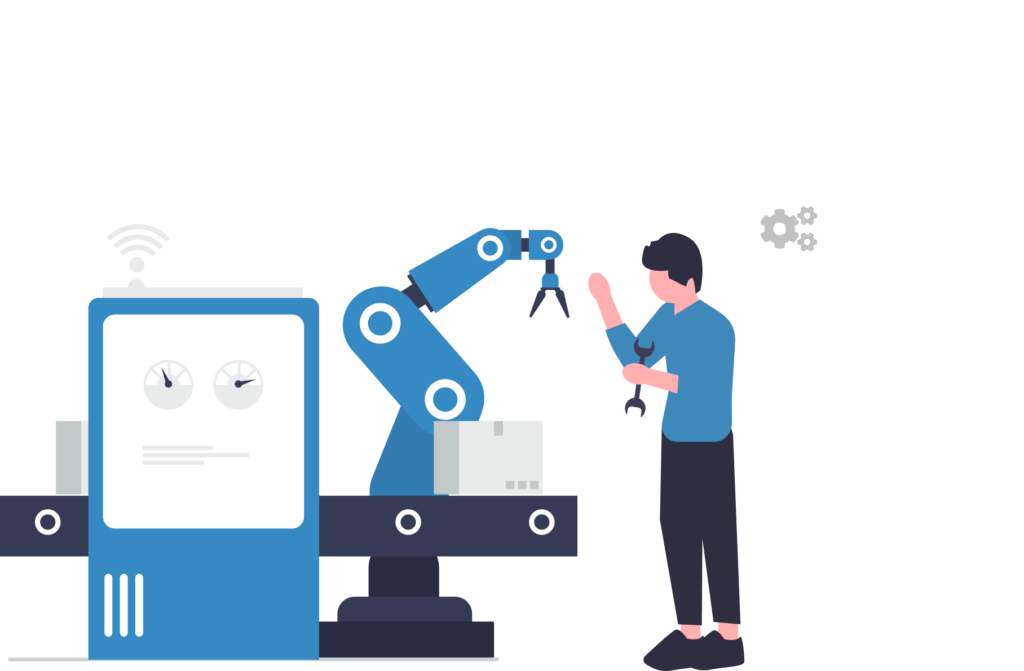Industrial Internet of Things: How It Can Work in Any Factory

Executive Summary
Industry 4.0, or the fourth industrial revolution, will see the digitization of the manufacturing industry through the incorporation of a range of technologies. One such technology is the Internet of Things (IoT) specifically applied to industry – or Industrial IoT (IIoT). Implementing an IIoT solution addresses typical challenges faced by factories – lack of real-time data about production/machine utilization/availability, line optimization, piece counting inaccuracy, and predictive maintenance of machines. An IIoT solution provides you with a holistic view of your factory operations to understand output and productivity levels and costly inefficiencies so that you are empowered to make the decisions that will help you reach your revenue goals. In this use case, we delve into the importance of Industry 4.0, common challenges faced by manufacturers, and how an IoT solution will work for your factory.
I am text block. Click edit button to change this text. Lorem ipsum dolor sit amet, consectetur adipiscing elit. Ut elit tellus.
Head of Sales , Intel

Introduction: The Importance of Industry 4.0
Industry has undergone transformations over the centuries – from the introduction of machines to factory floors and the use of energy sources to the use of technology. Industry 4.0 is the latest stage of this transformative process and it refers to the digitization of manufacturing processes. Digitization encompasses factory and warehouse operations, data collection, logistics and supply chain visibility, the functioning of machinery, and the efficiency of the workforce.
Industry 4.0 integrates new and emerging technologies such as IoT, Artificial Intelligence (AI) and Machine Learning (ML), and Augmented Reality (AR) into manufacturing processes. The end result is a ‘smart’ factory – one that leverages real-time data to refine their operations for the better through predictive analytics and automation.
A 2021 survey by McKinsey shows interesting results. Companies that adopted Industry 4.0 said they were better prepared to respond to the challenges created by the pandemic and its aftermath. 65% of respondents in the survey also said that Industry 4.0 is more important. This is hardly surprising. The world of today is beset with many uncertainties – economically and geopolitically. Businesses that want to respond to emerging challenges and remain relevant will gain a competitive advantage. Incorporating technology such as IoT will empower manufacturers to gain benefits such as:
Collect data contained in machines via sensors
Store data in a cost-effective manner using cloud based solutions
Automate repetitive manual functions
Analyze data to monitor the status of machines, maintain records of historical data, and perform predictive maintenance
Understand the efficiency of processes and workforce
Pursue other manufacturing opportunities
However, manufacturers and factory owners have many questions about making that initial investment into Industry 4.0 in spite of its many benefits. One of these is how an IIoT solution will help them overcome their day-to-day operational problems. In the next sections, we will explore 4 common operational problems manufacturers face, how to solve them with an IIoT solution, and how you can leverage the benefits.
Problem: The Lack of Real-Time Visibility
Any factory, whether it manufactures apparel, stationery, or FMCG products, has similar production lines. Production is often seasonal and the production planning process is complex. The latter involves multiple factors such as machine availability and functionality, availability of raw materials, labor capacity, and energy. Given these similarities, any factory faces 4 key challenges that impact its production capacity and revenue.
Machine utilization and availability
Different machines are used to perform different functions when manufacturing products. Therefore, each item will require its specific set of machines. When one factory does not have the required machine, a common practice is to lease it from a machine leasing company for the duration of manufacturing that particular item. This is a costly process and can be solved through the availability of real-time data about machine availability.
Factories, though they operate as different entities, receive production orders from conglomerates. Another factory that also produces goods for the conglomerate will have the required machine (or machines) and factories can borrow the required machines instead of leasing them.
Furthermore, product designers are often not aware of machine availability. The manufacturing timeline of any product depends on machine availability in addition to the availability of raw materials and shipping containers. Any time lags incurred when procuring raw materials and/or delaying sending the finished products to the containers adds to expenses.
A factory will have questions about how to gain insights into machine availability in real-time and save production costs.

Line optimization
In a production line, the machines are positioned according to the sequence of how each item will be manufactured. Production sequences often manufacture more than one item. For example, in a stationery manufacturing factory, the same production line will produce pens and crayons. In an apparel manufacturing factory, the same production line will produce many different types of garments.
Factory managers know the best sequence to ensure the efficiency of a production line. However, this efficiency depends on the performance of each employee. If one person performs tasks slowly, then there will be delays. A factory manager must have this information so they can shift employees along the product line to minimize delays. Currently, supervisors monitor each employee’s performance speed manually with the aid of a stopwatch. This is an impractical approach, as there can be many human errors (supervisors are responsible for multiple tasks). Also, it is impossible to appoint a supervisor for each production line.
Piece counting accuracy
When an employee completes their respective tasks in the production line, they are expected to keep count of their output per the targets set for their shifts. This does not often work accurately in practice as many factors can affect an employee’s productivity levels and each person has their own way of meeting their respective targets. Some production lines have a switch system to signal the completion of an item but installing switches in every production line is very costly.
Additionally, very few factory managers will have real-time updates about their factory’s production levels because of all the variables involved.
Predictive maintenance
Each machine has a productivity cycle where it will require maintenance or repairs after a certain time. If data about a machine’s maintenance history is available, then factory managers can identify patterns and anticipate a machine’s next maintenance schedule. This is where AI and ML capabilities will help, as these technologies enable you to process large data volumes for predictive analysis. The problem is, not many factories have access to this type of data at present.
The common thread connecting all 4 challenges is the lack of visibility over each aspect of the manufacturing process and the lack of real-time data about machine availability, production line efficiency, production output/level, and machine maintenance patterns.

Solution: Industrial IoT Middleware Solution Customized For Each Factory
An IoT middleware solution deployed in a manner that is customized for each factory’s needs enables factory owners to solve the challenges discussed earlier.

How a typical solution works
Each machine has a sensor that transmits data to a data sensor, which in turn is connected to the factory’s WiFi or ethernet network. There are 3 types of data:
Notifications
Data processing
Control
Each device communicates in its own language. The data is exposed as APIs via a connector into an IoT solution. Ideally, factories must use a device-agnostic IoT solution (such as Entgra IoT Platform) as they can add a connector of their choice. The data is then made available on customized dashboards, providing the factory with access to information as they need it.
Benefits and Results: Real-Time Data That Underpins Executive Decision Making
Centralized view of real-time data
The dashboards provide a holistic view of factory operations – the number of items produced per hour within a shift, the number of rejects (i.e. faulty products), the output of each production line and the time taken to complete processes, productivity levels of employees and their individual output throughout their shift duration. Data is also available for each design – availability of machines, their quantity and location, and how many are currently under maintenance.
All the above information is updated in real-time.
Improve manufacturing processes
With access to real-time visibility, factory managers can better understand the operational bottlenecks and how to improve the production times for each design. For example, supervisors no longer need to monitor employees’ performance manually – this is now an automated and more efficient process. The product counts are more accurate as again, this will no longer be a manual task. If the number of rejects are unusually high during a particular shift, the factory manager can examine the data to identify the origin of the problem. Factory managers can also temporarily use machines from another factory within the conglomerate to save leasing costs. Designers, too, can plan for production more efficiently as they are aware of machine availability.
Transparency for communications
Real-time visibility will add transparency to communications between factory managers, supervisors, and employees. For example, if supervisors are concerned about productivity levels, they now have the required data to support their conversations and decisions.
Executive decision making made easier
Ultimately, the ability to gain granular information about factory operations and output levels simplifies executive decision making. Decision makers will have the data to understand process delays and how they incur costs as they seek to maximize available financial resources. The real-time data will guide decisions based on insights gained from factory operations.
Next Steps
We presented you with the 4 common challenges that factories face and how a typical IoT solution will help you gain the data visibility required to optimize operations and reach revenue targets. Our many conversations with executive management along with factory managers and supervisors guide our approach when designing an IIoT solution for your specific business needs.

